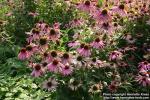2.8.1 Using Echinacea
(also see King's dispensatory, here: http://www.henriettes-herb.com/eclectic/kings/echinacea.html)
From Todd Caldecott (toddius.netidea.com):
In my training with NA's I learned that Echinacea (blood purifier and antibiotic) can be used as long as two weeks. The German research branch of their equivalent of FDA (called Komission E) Drs. Wagoner and Bauer demonstrated this fact. Their studies also showed that tinctured extract of this plant could be chemically potent or not depending on how it was grown, harvested and extracted. In their studies, the extracts available on the commercial market were far less potent than their own prepared version. So their conclusion was 2 weeks on then off for a week, then one could use it for another two weeks at diminished activity. Also the plant varieties of Echinacea angustifolia, E. purpurea and to a lesser extent E. pallida all had medicinal chemical activity. The whole plant is medicinal but needs to be at least 3 years old before you should harvest.
There is no evidence to suggest that Echinacea cannot be used longer than 2 weeks. In the original study (and please be patient I'm doing this from memory) Echinacea was found to be increasingly effective for 5 days, after which the study ceased. This paper, originally written in German, was mistranslated, leading one to believe that Echinacea's effects plateaued after five days. Echinacea is being used by several professionals long term. Typically though, it is used as a surface immune tonic, useful in chronically immunodepressed patients who suffer from chronic colds etc. (although its use in AIDS is still a matter of some controversy). For most of us who take it seasonally for colds etc. it is most effective when taken in combination with other herbs i.e. garlic, Baptisia, Thymus, Astragalus etc.
2.8.2 Echinacea - poaching and extinction
Thread on the phytopharmacognosy list:
> Over 90% of all Echinacea material in the U.S. and Europe comes from cultivated species. There is very little wild harvested ech. on the market. The claim that the use of ech. preparations contributes to the extinction of this plant species is nonsense. Such claims may apply to other medicinal plants but not to the easy to cultivate Ech. spp.
From P. Mick Richardson <richards.mobot.org>, to above:
Disappearance of the plant in the wild may be nonsense to you but it is reality to those of us who live in areas where the plant is native. Several points. The plant is easy to grow in cultivation but if you have no land on which to grow it you can get ready cash by collecting it in the wild. Even if 90% comes from cultivated sources, the remaining 10% is still a massive amount in relation to the ever decreasing number of plants in the wild, especially when consumption rises each year and the 10% translates into an ever increasing number of plants to be sought.
After receiving your message, I sought out a local person who collects seeds of Echinacea from wild plants in Missouri for cultivation of the plant. He confirmed my suspicions that the plant is becoming non-existent in many parts of Missouri as local populations are exterminated. So the nonsense is in fact reality to the people who see the plants. I suggest greater cultivation of the plant would decrease the demand for wild-harvested material. After all, no-one would be killing rhinos and elephants for sale if there was not a market for them. Let's stop before Echinacea becomes a great auk or a passenger pigeon example for textbooks. Sorry to ramble on, but extinction is for ever and it would be shameful for herbalists to contribute to it.
... and more in the same thread:
From: P. Mick Richardson <richards.mobot.org>:
It is illegal to collect Echinacea unless it is on your own property in Missouri. However, if someone offers cash for echinacea plants, then the demand will be met by poaching. Although on a lesser scale, it is no different to the situation with rhino horm and elephant ivory. If there is a cash market, people will provide the product. I could give descriptions of the nationalities of the buyers but this is probably unnecessary. The plants end up in Europe, presumably the site of greatest demand.
Hopefully, there will soon be enough Echinacea in cultivation that the price will fall and this may remove the demand for wild-collected plants. Until then, if you encourage the use of Echinacea, you endanger the plants growing wild in Missouri. Admittedly Echinacea is being poached on a lesser scale than Panax or Hydrastis, but it is still disappearing. Let's aim for complete domestication. It works for Ginkgo, which is a cultivated cash crop in the U.S.A. now.



